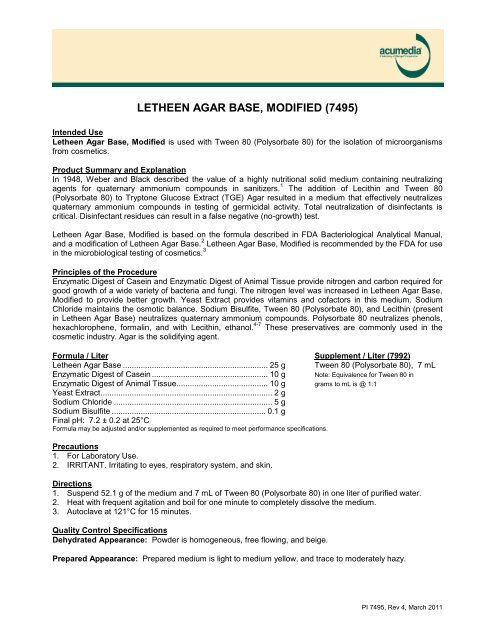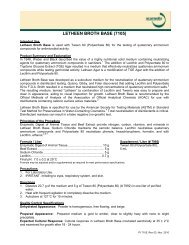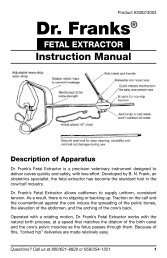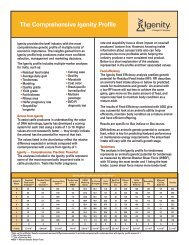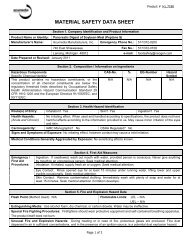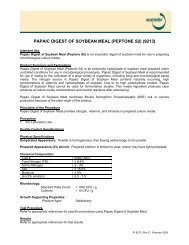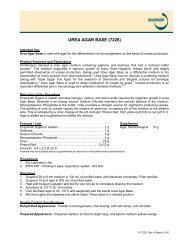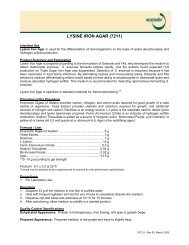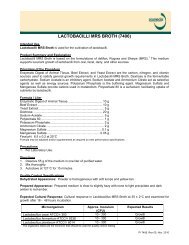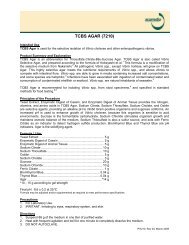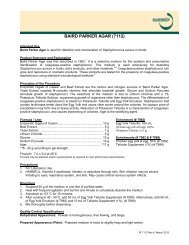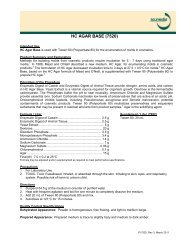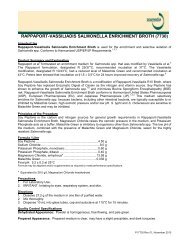Letheen Agar Base, Modified — 7495
Letheen Agar Base, Modified — 7495
Letheen Agar Base, Modified — 7495
You also want an ePaper? Increase the reach of your titles
YUMPU automatically turns print PDFs into web optimized ePapers that Google loves.
LETHEEN AGAR BASE, MODIFIED (<strong>7495</strong>)<br />
Intended Use<br />
<strong>Letheen</strong> <strong>Agar</strong> <strong>Base</strong>, <strong>Modified</strong> is used with Tween 80 (Polysorbate 80) for the isolation of microorganisms<br />
from cosmetics.<br />
Product Summary and Explanation<br />
In 1948, Weber and Black described the value of a highly nutritional solid medium containing neutralizing<br />
agents for quaternary ammonium compounds in sanitizers. 1 The addition of Lecithin and Tween 80<br />
(Polysorbate 80) to Tryptone Glucose Extract (TGE) <strong>Agar</strong> resulted in a medium that effectively neutralizes<br />
quaternary ammonium compounds in testing of germicidal activity. Total neutralization of disinfectants is<br />
critical. Disinfectant residues can result in a false negative (no-growth) test.<br />
<strong>Letheen</strong> <strong>Agar</strong> <strong>Base</strong>, <strong>Modified</strong> is based on the formula described in FDA Bacteriological Analytical Manual,<br />
and a modification of <strong>Letheen</strong> <strong>Agar</strong> <strong>Base</strong>. 2 <strong>Letheen</strong> <strong>Agar</strong> <strong>Base</strong>, <strong>Modified</strong> is recommended by the FDA for use<br />
in the microbiological testing of cosmetics. 3<br />
Principles of the Procedure<br />
Enzymatic Digest of Casein and Enzymatic Digest of Animal Tissue provide nitrogen and carbon required for<br />
good growth of a wide variety of bacteria and fungi. The nitrogen level was increased in <strong>Letheen</strong> <strong>Agar</strong> <strong>Base</strong>,<br />
<strong>Modified</strong> to provide better growth. Yeast Extract provides vitamins and cofactors in this medium. Sodium<br />
Chloride maintains the osmotic balance. Sodium Bisulfite, Tween 80 (Polysorbate 80), and Lecithin (present<br />
in <strong>Letheen</strong> <strong>Agar</strong> <strong>Base</strong>) neutralizes quaternary ammonium compounds. Polysorbate 80 neutralizes phenols,<br />
hexachlorophene, formalin, and with Lecithin, ethanol. 4-7 These preservatives are commonly used in the<br />
cosmetic industry. <strong>Agar</strong> is the solidifying agent.<br />
Formula / Liter Supplement / Liter (7992)<br />
<strong>Letheen</strong> <strong>Agar</strong> <strong>Base</strong> ................................................................. 25 g Tween 80 (Polysorbate 80), 7 mL<br />
Enzymatic Digest of Casein .................................................... 10 g Note: Equivalence for Tween 80 in<br />
Enzymatic Digest of Animal Tissue......................................... 10 g grams to mL is @ 1:1<br />
Yeast Extract ............................................................................. 2 g<br />
Sodium Chloride ....................................................................... 5 g<br />
Sodium Bisulfite ..................................................................... 0.1 g<br />
Final pH: 7.2 ± 0.2 at 25°C<br />
Formula may be adjusted and/or supplemented as required to meet performance specifications.<br />
Precautions<br />
1. For Laboratory Use.<br />
2. IRRITANT. Irritating to eyes, respiratory system, and skin.<br />
Directions<br />
1. Suspend 52.1 g of the medium and 7 mL of Tween 80 (Polysorbate 80) in one liter of purified water.<br />
2. Heat with frequent agitation and boil for one minute to completely dissolve the medium.<br />
3. Autoclave at 121°C for 15 minutes.<br />
Quality Control Specifications<br />
Dehydrated Appearance: Powder is homogeneous, free flowing, and beige.<br />
Prepared Appearance: Prepared medium is light to medium yellow, and trace to moderately hazy.<br />
PI <strong>7495</strong>, Rev 4, March 2011
Expected Cultural Response: Cultural response on <strong>Letheen</strong> <strong>Agar</strong> <strong>Base</strong>, <strong>Modified</strong> incubated aerobically at<br />
35 ± 2°C and examined for growth after 18 - 24 hours.<br />
Microorganism Approx. Inoculum (CFU) Expected Results<br />
Enterococcus faecalis ATCC 29212 10 - 300 Growth<br />
Escherichia coli ATCC 25922 10 - 300 Growth<br />
Pseudomonas aeruginosa ATCC 27853 10 - 300 Growth<br />
Salmonella typhimurium ATCC 14028 10 - 300 Growth<br />
Staphylococcus aureus ATCC 25923 10 - 300 Growth<br />
The organisms listed are the minimum that should be used for quality control testing.<br />
Test Procedure 3<br />
1. Prepare and dilute samples in <strong>Letheen</strong> Broth <strong>Base</strong>, <strong>Modified</strong> in accordance with established guidelines.<br />
2. Using the spread plate technique, inoculate in duplicate 0.1 mL of the diluted samples onto <strong>Letheen</strong> <strong>Agar</strong><br />
<strong>Base</strong>, <strong>Modified</strong>, Potato Dextrose <strong>Agar</strong> containing Chlortetracycline, Baird Parker <strong>Agar</strong>, Anaerobic <strong>Agar</strong>,<br />
and a second set of <strong>Letheen</strong> <strong>Agar</strong> <strong>Base</strong>, <strong>Modified</strong> plates.<br />
3. Incubate one set of <strong>Letheen</strong> <strong>Agar</strong> <strong>Base</strong>, <strong>Modified</strong> at 30°C for 48 hours and the other set at 35°C under<br />
anaerobic conditions for 2 - 4 days. Incubate the Potato Dextrose <strong>Agar</strong> plates at 30°C for 7 days and the<br />
Baird Parker <strong>Agar</strong> plates, if inoculated, at 35°C for 48 hours.<br />
4. Incubate diluted samples from Step 1 at 35°C for 7 days. Subculture enriched samples onto <strong>Letheen</strong><br />
<strong>Agar</strong> <strong>Base</strong>, <strong>Modified</strong> only if there is no growth on the primary <strong>Letheen</strong> <strong>Agar</strong> <strong>Base</strong>, <strong>Modified</strong>.<br />
Results<br />
Examine plates for evidence of growth and characteristic colonial morphology. Determine colony counts and<br />
subculture each colony type onto <strong>Letheen</strong> <strong>Agar</strong> <strong>Base</strong>, <strong>Modified</strong> and MacConkey <strong>Agar</strong> (also Baird Parker if<br />
used in Step 2).<br />
Storage<br />
Store sealed bottle containing the dehydrated medium at 2 - 30°C. Once opened and recapped, place<br />
container in a low humidity environment at the same storage temperature. Protect from moisture and light.<br />
Expiration<br />
Refer to expiration date stamped on the container. The dehydrated medium should be discarded if not free<br />
flowing, or if appearance has changed from the original color. Expiry applies to medium in its intact container.<br />
Limitation of the Procedure<br />
Due to nutritional variation, some strains may grow poorly or fail to grow on this medium.<br />
Packaging<br />
<strong>Letheen</strong> <strong>Agar</strong> <strong>Base</strong>, <strong>Modified</strong> Code No. <strong>7495</strong>A 500 g<br />
<strong>7495</strong>B 2 kg<br />
<strong>7495</strong>C 10 kg<br />
Tween 80 (Polysorbate 80) 7992 100 mL<br />
References<br />
1. Weber, G. R., and L. A. Black. 1948. Relative efficiency of quaternary inhibitors. Soap and Sanit. Chem. 24:134-139.<br />
2. Tomlinson, L. (ed.). 1992. FDA Bacteriological Analytical Manual, 7 th ed. AOAC International, Arlington, VA.<br />
3. Hitchins, A. D., T. T. Tran, and J. E. McCarron. 1992. In Tomlinson, L. A. (ed.). FDA Bacteriological Analytical Manual, 7 th ed. AOAC International,<br />
Arlington, VA.<br />
4. Quisno, R., I. W. Gibby, and M. J. Foter. 1946. A neutralizing medium for evaluating the germicidal potency of the quaternary ammonium salts. Am. J.<br />
Pharm. 118:320-323.<br />
5. Erlandson, A. L., Jr., and C. A. Lawrence. 1953. Inactivating medium for hexachlorophene (G-11) types of compounds and some substituted phenolic<br />
disinfectants. Science. 118:274-276.<br />
6. Brummer, B. 1976. Influence of possible disinfectant transfer on Staphylococcus aureus plate counts after contact sampling. Appl. Environ. Microbiol.<br />
32:80-84.<br />
7. Favero (chm.). 1967. Microbiological sampling of surfaces-a state of the art report. Biological Contamination Control Committee, American Association<br />
for Contamination Control.<br />
Technical Information<br />
Contact Acumedia Manufacturers, Inc. for Technical Service or questions involving dehydrated culture media preparation or<br />
performance at (517)372-9200 or fax us at (517)372-2006.<br />
PI <strong>7495</strong>, Rev 4, March 2011


